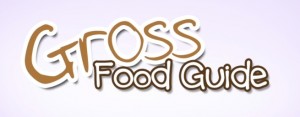 Crowdfunding poses some interesting questions in terms of marketing and explaining your project.
Crowdfunding poses some interesting questions in terms of marketing and explaining your project.
On the one hand you want to demonstrate you have a viable business idea and a professional product. On the other hand, you want to let people see the personal side to what motivates and drives your (hopefully) great idea. Getting the balance between personal story and professional product is crucial. And, I think it’s fair to say, it’s not a balance I’ve achieved that well so far with The Gross Food Guide campaign. Having opted to present a polished product with good production values I maybe have failed to explain exactly why this project matters to me.
So I’m going to try and remedy that by sharing with you just why I want to create The Gross Food Guide. Here goes…
For the last 18 months I’ve been developing a creative idea very close to my heart. It’s a kid’s food project based on four fictional characters, Dill, Olive, Sprout and Pickle, who travel the world and even go back in time (with the help of a magic book of course!) to discover the weird, wacky and amazing stories behind the food we eat.
The principle behind the project is one a lot of us can identify with. It is, simply, that our children are growing up in a world where they have lost their connection to the real value of food. As a result they often don’t appreciate the food they eat, where it comes from and why certain foods will be tastier and better for them than others.
This lack of education and appreciation already is having major ramifications on our children’s health - most notably through the amount of processed salt and sugar they consume and are encouraged to consume by the food industry and the media. In the future this disconnect between the food we eat and where it comes from will also have global implications on sustainable living as our eating habits create an increasing strain on natural resources and energy.
Frankly, that’s a bit of a heavy message for your average 6 - 10 year old. They’d much prefer play an online game or watch a TV cartoon that’s funny and full of adventure. Which is why I came up with The Gross Food Guide - a “hit em over the head” way of opening kids eyes to the weird, wonderful and, yes, quite gross, foods we all like to eat around the world and why different cultures celebrate them.
The plan for The Gross Food Guide is to create an App that helps kids explore the culture around strange global food, laugh at just how gross some foods are but also learn why these foods are important and matter. Take crispy ‘French-fried” caterpillars from Mexico or lake fly “burgers” from Malawi. To most young Western palates these bug dishes probably seem quite gross. But when you show kids that these foods provide an essential form of protein and sustenance for local people and you intrigue them with the way the food is collected, prepared and served, they don’t seem so gross after all.
The same is true for cultural delicacies like Haggis in Scotland, frog’s legs in France and maggot-infested Casu Marzu cheese from Sardinia. Many people around the world would find these Old World traditions just as caterpillars and termites (eaten like popcorn in parts of Uganda and Ghana). But when you explain why these foods matter to local people and why they help bind communities together, even the grossest foods start making sense.
Most of the “gross foods” considered for the guide have a distinct advantage over the processed fast food our children are encouraged to eat each day: namely they are sustainably sourced (though frog’s legs have serious issues), have strong cultural ties, are made from fresh, natural ingredients (some still alive admittedly) and have real nutritional value. And in the case of Moroccan Argan Oil, it has become a global cosmetics phenomenon without the majority of its consumers realising the traditional method of extracting the oil involved sifting through goat’s poo!
Like anything when it comes to our children, there’s no point telling them something is important - you have to show them why it is important and then they learn. That’s why the first stage of my Gross Food project is the App and why, rather than adopt an overtly “let’s save the planet” approach, the App instead will try and get kids laughing at what we all like to eat. Through laughing they’ll also start learning about where food comes from and why we need to appreciate what goes on our plates.
If you’d like to learn more about The Gross Food Guide and help crowdfund the App, visit Indiegogo



